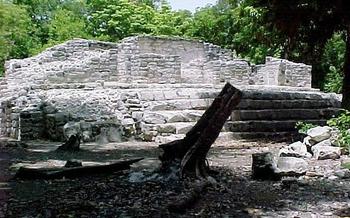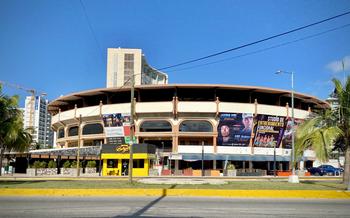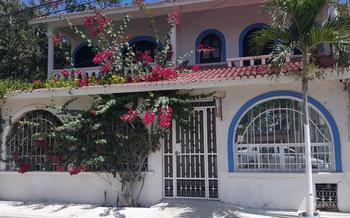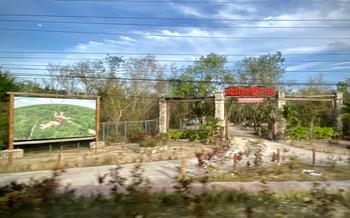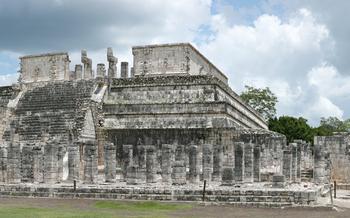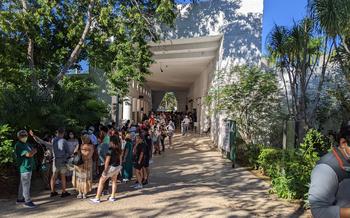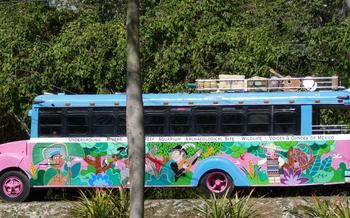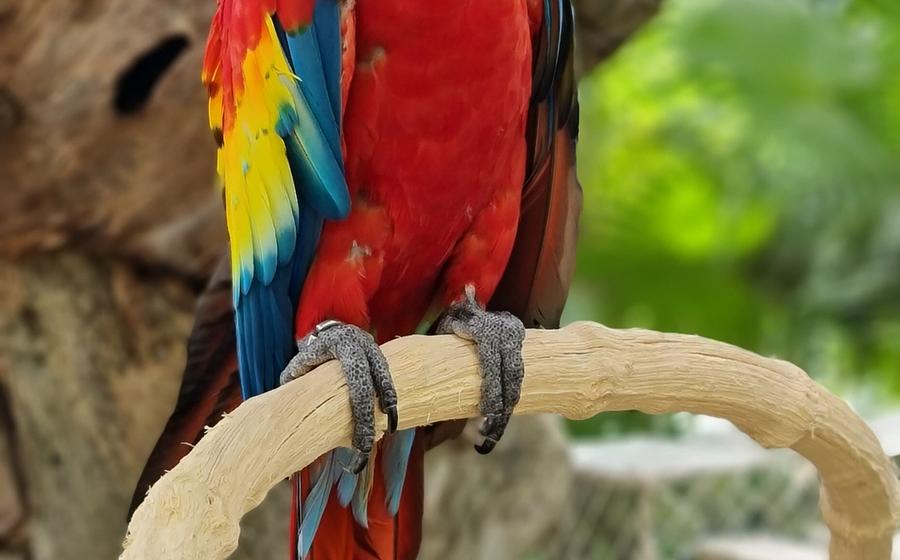
Coba Archaeological Site
- Unveiling the Ancient Grandeur: Exploring the Main Pyramids of Coba
- Unraveling the Secrets of Stelae: Reading the Past Through Inscriptions
- A Journey Through Time: Unveiling the Ball Court and Ancient Mayan Sports
- Sacred Waters: Exploring the Cenotes of Coba
- Cultural Immersion: Interacting with the Mayan Community
- Culinary Journey: Savoring the Flavors of Mayan Cuisine
- Nature's Sanctuary: Admiring the Flora and Fauna of Coba's Jungle
- Archaeological Insights: Learning from the Past at the Coba Museum
- A Photographer's Paradise: Capturing the Beauty of Coba
- Sustainable Tourism: Respecting the Environment and Local Culture
- Planning Your Visit: Tips for a Hassle-Free Experience
- Getting There: Navigating Transportation Options to Coba
- Insider Tip: Unveiling a Hidden Gem
Unveiling the Ancient Grandeur: Exploring the Main Pyramids of Coba
Amidst the lush jungle of Coba, the towering pyramids stand as testaments to the ingenuity and architectural prowess of the ancient Maya. The most prominent among them is Nohoch Mul, the tallest structure at the site. Ascending its steep steps, visitors are rewarded with breathtaking panoramic views that stretch across the jungle canopy, revealing the vastness of the ancient city.
This pyramid, which translates to "Big Hill" in the Maya language, is believed to have served as both a temple and an astronomical observatory. Its intricate carvings and sculptures offer glimpses into the Maya's profound understanding of celestial cycles and their connection to the divine.
Climbing Nohoch Mul requires physical effort, but the experience is well worth the challenge. The ascent provides an opportunity for visitors to connect with the ancient Maya, who built these structures without the aid of modern tools or machinery.
As you reach the summit and gaze upon the sprawling jungle below, you can't help but feel a sense of awe and wonder. It's a moment to pause and reflect on the rich history and legacy of this ancient civilization.
Personal Anecdote:
I remember my first ascent of Nohoch Mul vividly. As I climbed the steep steps, my heart pounded with excitement and anticipation. When I finally reached the top, I was greeted by a breathtaking panorama that stretched as far as the eye could see. The lush green jungle, dotted with ancient ruins, seemed to stretch on forever.
Standing there, surrounded by the remnants of a civilization that thrived over a thousand years ago, I couldn't help but feel a profound connection to the past. It was an unforgettable moment that left me with a deep appreciation for the Maya's incredible achievements.
Unraveling the Secrets of Stelae: Reading the Past Through Inscriptions
Stelae, or carved stone monuments, are like windows into the past, offering invaluable insights into the lives and achievements of ancient Mayan rulers. At Coba, these enigmatic monoliths stand as silent witnesses to the city's rich history and cultural significance.
The stelae are adorned with intricate carvings and hieroglyphic texts, forming a complex narrative that chronicles the lineage, conquests, and accomplishments of the city's rulers. These inscriptions serve as a testament to the advanced writing system developed by the Maya, enabling them to record their history and religious beliefs in a sophisticated and enduring form.
One particularly striking stela at Coba is Stela 1, which depicts the Maya ruler K'inich Yax K'uk' Mo', or "Sun-faced Maize God." The stela showcases the ruler's divine status, adorned with elaborate headdresses and symbols of power and authority. The hieroglyphic text accompanying the stela provides a detailed account of his accession to the throne, his military victories, and his role in maintaining peace and stability within the kingdom.
Deciphering the stories etched on these stelae is a fascinating endeavor, allowing us to piece together the intricate tapestry of Coba's past. Each stela holds clues to the city's political alliances, trade networks, and cultural exchanges with other Mayan city-states. By studying these inscriptions, we gain a deeper understanding of the complex social and political dynamics that shaped the Maya civilization.
For those with a keen interest in ancient history and hieroglyphics, Coba's stelae offer a captivating opportunity to engage with the written legacy of the Maya. These monuments stand as a testament to the enduring power of the written word, preserving the stories of a once-thriving civilization for generations to come.
A Journey Through Time: Unveiling the Ball Court and Ancient Mayan Sports
Amidst the sprawling ruins of Coba, a remarkable spectacle awaits visitors—the ancient ball court, one of the largest and most well-preserved in the Mayan world. Measuring an impressive 166 meters in length and 75 meters in width, this colossal arena once hosted the thrilling and sacred Mesoamerican ball game, a ritual deeply embedded in Mayan culture and religion.
The rules of the game remain shrouded in mystery, but it is believed to have involved two teams using their hips, elbows, or knees to maneuver a heavy rubber ball through stone hoops attached to the court walls. The objective was not simply to score goals but to engage in a symbolic battle that mirrored the cosmic struggle between light and darkness.
Beyond its sporting significance, the ball game held profound cultural and religious implications. It was closely associated with fertility, agricultural cycles, and the cyclical nature of the universe. Victories were celebrated with elaborate rituals and offerings to the gods, while defeats were believed to have dire consequences for the community.
To witness a traditional ball game demonstration at Coba is to step back in time and experience the vibrant energy and excitement of this ancient ritual. The air crackles with anticipation as the players, adorned in traditional Mayan attire, enter the court. The rhythmic thud of the ball against the stone walls echoes through the jungle, accompanied by the cheers and chants of the spectators.
As the game unfolds, one can't help but be captivated by the skill, agility, and athleticism of the players. Their fluid movements and precise strikes showcase the mastery and dedication required to excel in this demanding sport. The atmosphere is electric, and the crowd is swept up in the fervor of the game, cheering for their favorite team and invoking the blessings of the Mayan gods.
Whether you're a history buff, a sports enthusiast, or simply someone fascinated by the vibrant tapestry of ancient cultures, witnessing a traditional ball game demonstration at Coba is an unforgettable experience that offers a glimpse into the heart and soul of the Mayan civilization.
Sacred Waters: Exploring the Cenotes of Coba
The archaeological site of Coba is blessed with a network of pristine cenotes, natural sinkholes that were considered sacred by the ancient Mayans. These mystical water bodies hold a profound spiritual significance, as they were believed to be gateways to the underworld and the afterlife.
Within the confines of the archaeological site, you'll find two cenotes that are open to the public for swimming and exploration: Cenote Choo-Ha and Cenote Tankach-Ha. Both cenotes offer a refreshing respite from the tropical heat and a unique opportunity to immerse yourself in the natural beauty of the Mayan jungle.
Cenote Choo-Ha is a large, open cenote with crystal-clear waters and a depth of around 6 meters. Surrounded by lush vegetation, it's a great spot for swimming, snorkeling, and enjoying the tranquility of the jungle.
Cenote Tankach-Ha, on the other hand, is a smaller and more secluded cenote, hidden deep within the jungle. With its emerald-green waters and dramatic rock formations, it's an ideal place for snorkeling and diving, offering a glimpse into the fascinating underwater world of the cenotes.
To enhance your cenote experience, consider bringing your own snorkeling gear or renting it from local vendors. Remember to wear water shoes or sandals to protect your feet from the rocky bottom and sharp objects.
Swimming in the cenotes is a magical experience, allowing you to connect with the ancient Maya and their sacred traditions. As you float in the crystal-clear waters, surrounded by the towering pyramids and the lush jungle, you'll feel a sense of awe and wonder that will stay with you long after your visit.
Cultural Immersion: Interacting with the Mayan Community
The Coba Archaeological Site offers a unique opportunity to connect with the living legacy of the Mayan people. Within the surrounding area, several Mayan communities continue to thrive, preserving their ancient traditions, customs, and way of life.
Engage in meaningful interactions with the local Mayan people by visiting their villages, attending cultural events, or participating in workshops. Learn about their traditional crafts, such as weaving, pottery, and woodcarving, and witness their skills firsthand. Discover the secrets of Mayan cuisine by taking a cooking class or savoring authentic dishes prepared by local families.
Support local businesses and initiatives by purchasing handmade souvenirs, visiting Mayan-owned restaurants, or booking tours with local guides. These interactions not only provide a glimpse into the rich Mayan culture but also contribute to the economic well-being of the community.
Personal Anecdote:
During my visit to Coba, I had the privilege of meeting a Mayan artisan named Maria. In her humble workshop, she demonstrated her mastery of traditional weaving techniques, creating vibrant and intricate textiles. As she shared stories about her family's history and the significance of her craft, I felt a deep connection to the living heritage of the Mayan people. Purchasing one of her beautiful handmade pieces not only supported her livelihood but also gave me a tangible reminder of the cultural richness of this region.
Culinary Journey: Savoring the Flavors of Mayan Cuisine
Embark on a gastronomic adventure as you savor the tantalizing flavors of Mayan cuisine. Immerse yourself in the vibrant culinary traditions of the Yucatan Peninsula, where ancient recipes and local ingredients blend harmoniously to create a symphony of flavors. Indulge in the delectable cochinita pibil, a slow-roasted pork dish infused with achiote paste and wrapped in banana leaves. Delight your palate with panuchos, crispy tortillas topped with refried beans, cochinita pibil, and pickled red onions. Satisfy your cravings with salbutes, another tortilla-based dish topped with turkey, shredded lettuce, and a tangy tomato sauce.
Venture beyond the archaeological site and explore the nearby villages, where you can find authentic Mayan restaurants and street food stalls. Engage with the friendly locals and learn about their culinary heritage as you savor the flavors that have been passed down through generations. Support local businesses by purchasing traditional Mayan crafts and souvenirs, contributing to the preservation of their rich cultural traditions.
Personal Anecdote:
My culinary journey at Coba was a delightful adventure that transported me back in time. Strolling through the vibrant streets of a nearby village, I stumbled upon a small, unassuming restaurant that exuded an air of authenticity. The aroma of freshly made tortillas and the sounds of sizzling ingredients filled the air, drawing me inside. I ordered a plate of cochinita pibil, and as I took my first bite, I was transported to a realm of culinary bliss. The succulent pork melted in my mouth, and the complexity of flavors danced on my taste buds. It was a moment of sheer gastronomic delight, where the culinary heritage of the Mayans came alive in every bite.
Nature's Sanctuary: Admiring the Flora and Fauna of Coba's Jungle
Beyond the ancient ruins, Coba is home to a thriving jungle ecosystem teeming with diverse plant and animal life. As you explore the site, keep your eyes peeled for monkeys swinging through the trees, colorful toucans perched on branches, and graceful iguanas basking in the sun. The jungle is also home to a variety of other creatures, including snakes, spiders, and insects, so be sure to tread carefully and respect their natural habitat.
Take some time to appreciate the lush vegetation that surrounds you. Coba's jungle is home to a wide variety of trees, including towering ceiba trees with their distinctive buttress roots, as well as mahogany, cedar, and tropical fruit trees. The understory is filled with ferns, orchids, and other tropical plants, creating a verdant tapestry of life.
The jungle also plays a vital role in the local ecosystem. It provides habitat for wildlife, helps to regulate the climate, and protects the water resources of the region. By visiting Coba, you are helping to support the preservation of this important ecosystem.
Personal Anecdote
During my visit to Coba, I was lucky enough to spot a family of spider monkeys swinging through the trees. It was an amazing sight to see these agile creatures leaping from branch to branch, their long tails trailing behind them. I also spotted several toucans, their vibrant beaks and plumage standing out against the green foliage.
One of my most memorable experiences was swimming in a cenote surrounded by lush jungle vegetation. The water was crystal clear and refreshing, and I felt like I was in a hidden paradise. As I floated in the water, I could hear the sounds of birds singing and monkeys chattering in the trees above. It was a truly magical experience that I will never forget.
Archaeological Insights: Learning from the Past at the Coba Museum
Enrich your understanding of Coba's captivating history and culture by visiting the on-site museum. This treasure trove of knowledge houses a wealth of artifacts, replicas, and interactive displays that bring the ancient Mayan civilization to life. Gain insights into the daily lives, beliefs, and customs of the Maya as you explore the museum's exhibits. Learn about the significance of Coba's architecture, art, and hieroglyphs, and uncover the secrets of their advanced calendar system. The Coba Museum is a testament to the enduring legacy of the Maya and a must-visit for anyone seeking a deeper connection to this fascinating civilization.
In one exhibit, I stumbled upon an intricately carved jade mask, believed to have belonged to a high-ranking Maya lord. The exquisite craftsmanship and attention to detail were breathtaking, and I couldn't help but imagine the stories it could tell. In another section, I learned about the Maya's sophisticated writing system, with its intricate glyphs representing syllables and concepts. Seeing these ancient symbols, I felt a profound connection to the Maya's intellectual achievements. The Coba Museum is not just a repository of artifacts; it's a gateway to understanding the Maya's rich cultural heritage and their enduring impact on our world.
A Photographer's Paradise: Capturing the Beauty of Coba
Coba's natural and cultural wonders offer a feast for the eyes, making it a paradise for photographers of all skill levels. Capture the grandeur of the towering pyramids against the backdrop of the lush jungle canopy. Immortalize the intricate carvings and hieroglyphs that adorn the ancient temples. Dive into the refreshing cenotes, surrounded by stalactites and stalagmites, and capture the interplay of light and shadow on the water's surface.
Seek out unique angles and perspectives to create dynamic compositions. Climb the steep steps of the Nohoch Mul pyramid for a bird's-eye view of the entire site. Explore the lesser-known corners of Coba to uncover hidden gems and capture intimate moments of nature and history.
Plan your visit during the golden hours of sunrise or sunset to harness the warm, diffused light that casts a magical glow on the ancient ruins. Experiment with different camera settings and techniques to capture the vibrant colors of the jungle, the textures of the stone structures, and the ethereal atmosphere of the site.
Don't forget to respect the sanctity of the site and minimize your impact on the environment. Use a telephoto lens to photograph wildlife from a distance without disturbing their natural behavior. Follow designated trails and avoid venturing into restricted areas.
My favorite photo from Coba captures the moment when a lone toucan perched itself atop the highest branch of a towering ceiba tree, its vibrant plumage contrasting against the deep green foliage. The backdrop of the ancient ruins added a sense of timelessness and wonder to the scene.
Sustainable Tourism: Respecting the Environment and Local Culture
As you embark on your journey to Coba, it's essential to embrace responsible tourism practices that minimize your environmental impact and respect the local culture. Tread lightly on the ancient grounds, leaving no trace of your presence. Refrain from touching or climbing on the fragile ruins, as they are irreplaceable relics of the past. Embrace the opportunity to learn about Mayan culture and traditions through respectful interactions with the local community. Support local businesses by purchasing souvenirs from artisans and dining at family-owned restaurants, contributing directly to the preservation of their heritage. Together, we can ensure that Coba remains a vibrant and sustainable destination for generations to come.
Planning Your Visit: Tips for a Hassle-Free Experience
Visiting Coba requires careful planning to ensure a smooth and enjoyable experience. The best time to visit is during the dry season, which runs from November to April, when the weather is generally pleasant and dry. To avoid the crowds and enjoy a more peaceful exploration, aim to arrive early in the morning or late in the afternoon.
Deciding whether to explore independently or with a guided tour depends on your preferences and budget. Guided tours offer valuable insights into the site's history and culture, but they can be more expensive. If you choose to go it alone, be sure to do some research beforehand and bring a map or guidebook to help you navigate the site.
Personal Anecdote:
During my first visit to Coba, I made the mistake of arriving in the middle of the day, and the heat and humidity were overwhelming. I quickly realized the importance of starting early to avoid the worst of the heat. On my subsequent visits, I made sure to arrive early in the morning and had a much more enjoyable experience.
Getting There: Navigating Transportation Options to Coba
Reaching Coba from major tourist hubs like Cancun, Playa del Carmen, or Tulum is a relatively straightforward journey. Whether you prefer public transportation, the comfort of a taxi, or the freedom of a rental car, there are options to suit every budget and preference.
By Bus: For budget-conscious travelers, ADO buses offer a reliable and affordable way to get to Coba. Buses depart from Cancun, Playa del Carmen, and Tulum throughout the day, and the journey takes approximately 2-3 hours. Once you arrive in Coba, local taxis or colectivos (shared vans) can take you to the archaeological site entrance.
By Taxi: If you prefer a more direct and convenient option, taxis are readily available at all three cities. While taxis offer door-to-door service, they tend to be more expensive than buses. Negotiate the fare in advance to avoid surprises, and ensure that the taxi driver uses the meter, if available.
By Rental Car: For those who enjoy the flexibility of exploring at their own pace, renting a car is a great choice. Rental cars can be booked in advance or upon arrival at Cancun International Airport or Playa del Carmen. Driving to Coba is straightforward, and the roads are generally well-maintained. However, parking can be limited at the archaeological site, so arrive early to secure a spot.
Personal Anecdote:
During my first visit to Coba, I opted for the ADO bus from Playa del Carmen. The journey was smooth, and the bus was comfortable and air-conditioned. Upon arrival in Coba, I hopped on a colectivo to reach the site entrance. The local driver was friendly and shared interesting stories about the area during the short ride.
Insider Tip: Unveiling a Hidden Gem
Beyond the main attractions of Coba, there lies a hidden world waiting to be discovered by adventurous travelers. For those willing to venture off the beaten path, there are several secret spots and lesser-known attractions that offer a unique and unforgettable experience.
One such hidden gem is the Xaibe Cenote, located just a short walk from the main archaeological site. This secluded cenote is surrounded by lush vegetation and towering limestone cliffs, creating a serene and mystical atmosphere. With its crystal-clear waters and abundance of colorful fish, it's an ideal spot for swimming, snorkeling, or simply relaxing in nature's embrace.
Another hidden treasure is the Sacbé 1 Road, an ancient Mayan causeway that once connected Coba with other major cities in the region. This impressive road, which stretches for several kilometers, is lined with towering trees and offers a glimpse into the engineering prowess of the ancient Maya. Visitors can explore the road on foot or by bicycle, enjoying the tranquility of the jungle and the chance to spot wildlife along the way.
For those seeking a more challenging adventure, the Coba Climb is a must-do. This grueling hike takes you to the summit of Nohoch Mul, the tallest pyramid at Coba, offering unparalleled views of the surrounding jungle and the turquoise waters of the Caribbean Sea. The climb is physically demanding, but the breathtaking vistas and the sense of accomplishment make it well worth the effort.
These hidden gems are just a taste of what awaits those who are willing to explore beyond the main tourist areas of Coba. Whether you're seeking tranquility, adventure, or a glimpse into the past, there's something for everyone in this ancient Mayan city.
